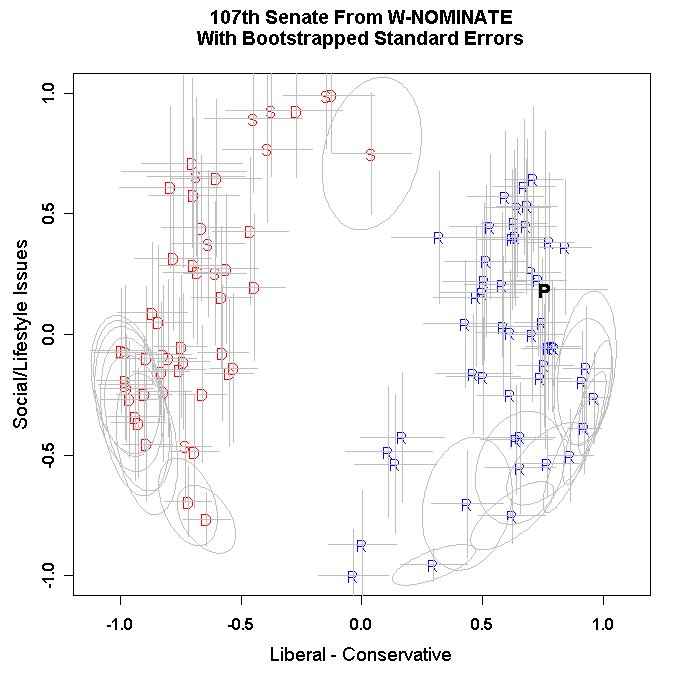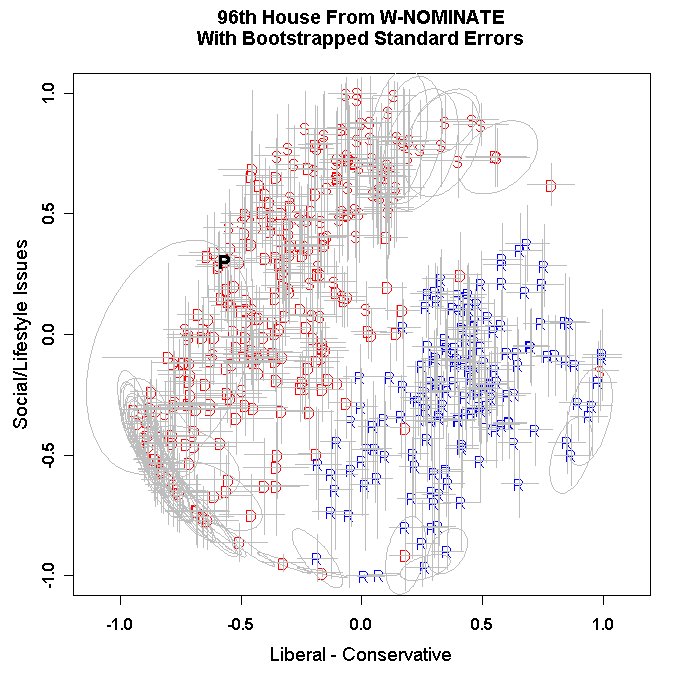W-NOMINATE Parametric Bootstrap Program
Jeff Lewis and Keith Poole
(Updated 24 October 2006)
Examples
SEN107KH.ORD Data File Name -- can include path statement
NOMINAL MULTIDIMENSIONAL UNFOLDING OF 107th SENATE Title of Run
633 10 18 Number RCs, Left on 1st, Up on 2nd
2 36 1001 Number Dimensions, Number Characters to Read From Header, Number of Bootstrap Trials
15.0000 0.5000 Starting Values for BETA and WEIGHT
0.0250 20 RC Min. Cutoff, Number RCs for Legislator
(36A1,3600I1) Format for Roll Call File
(1X,I4,36A1,1X,4I4,51F7.3) Format for Legislator Coordinate File -- NOM31.DAT
(1X,I4,36A1,80F10.4) Format for W-NOMINATE, H-S, and Metric Coordinate File -- NOM36.DAT --
and FORT.26 -- The Parametric Bootstrap Legislator Coordinates and Standard Errors
006330001000018 and 000020003601001This spacing must not be changed! If you want to analyze 1221 roll calls in 3 dimensions with everything else the same the two lines must look like this:
012210001000018
000030003601001
or with the zeroes removed
1221 10 18
3 36 1001
Although in this setup we have the number of bootstrap trials set to 1001 we
recommend that the user set this to either 11 or 6 (00011 or 00006) initially
and study the output files before doing a large number of trials.
1 1079991099 0USA 20000BUSH 0.7605 0.1849 0.8266 0.1409 0.1312 0.3363 1.0000 -0.0440 -0.0440 1.0000
2 1074970041 0ALABAMA 20001SESSIONS 0.6413 -0.4361 0.6926 -0.4954 0.0758 0.1152 1.0000 0.0533 0.0533 1.0000
3 1079465941 0ALABAMA 20001SHELBY 0.5048 -0.1749 0.5646 -0.2032 0.0784 0.1246 1.0000 0.0532 0.0532 1.0000
4 1071490781 0ALASKA 20001MURKOWSKI 0.6319 0.4609 0.6786 0.4407 0.0707 0.1546 1.0000 0.0646 0.0646 1.0000
5 1071210981 0ALASKA 20001STEVENS 0.5176 0.3038 0.5899 0.3249 0.0887 0.1598 1.0000 0.0395 0.0395 1.0000
etc etc etc
The first column is an integer counter
The column in red is the Congress number
The column in blue is the ICPSR ID Number
The column in Magenta is the ICPSR State Code
The column of zeroes will show the two digit Congressional District Number for House Roll Call Matrices
The column in Coral is the first seven letters of the State Name
The column in Midnightblue is the party code -- see the Party Codes Page for a complete listing
The column in Firebrick are the ICPSR Occupancy and Election Codes
Name of Senator/Representative
The columns in Turquoise are the W-NOMINATE Coordinates.
The columns in Purple are the Mean Coordinate Values For the 1000 Trials
The columns in Green are the Parametric Bootstrapped Standard Errors
The last four columns are the Pearson Correlation Matrix between the two dimensions. The column
in Deeppink is the Pearson Correlation Between the First and
Second Dimension Coordinate estimates across the 1000 Bootstrap Trials
This can be used to obtain the corresponding covariance term
etc etc etc
98 1071492256 0WEST VI 10001ROCKEFELLER -0.7407 -0.1129 -0.7197 -0.1616 0.0551 0.1440 1.0000 -0.0500 -0.0500 1.0000
99 1074930925 0WISCONS 10001FEINGOLD -0.7206 -0.6933 -0.7128 -0.6586 0.0497 0.0739 1.0000 -0.3755 -0.3755 1.0000
100 1071570325 0WISCONS 10001KOHL -0.5807 0.1534 -0.5395 0.0984 0.0638 0.1491 1.0000 0.0402 0.0402 1.0000
101 1074970668 0WYOMING 20001ENZI 0.7769 0.3826 0.7873 0.3420 0.0529 0.1471 1.0000 0.1047 0.1047 1.0000
102 1071563368 0WYOMING 20001THOMAS 0.8422 0.3621 0.8374 0.3115 0.0555 0.1420 1.0000 0.0080 0.0080 1.0000

HOU96KH.ORD Data File Name -- can include path statement
NOMINAL MULTIDIMENSIONAL UNFOLDING OF 96TH HOUSE Title of Run
1276 1 4 Number RCs, Left on 1st, Up on 2nd
2 36 1001 Number Dimensions, Number Characters to Read From Header, Number of Bootstrap Trials
15.0000 0.5000 Starting Values for BETA and WEIGHT
0.0250 20 RC Min. Cutoff, Number RCs for Legislator
(36A1,15000I1) Format for Roll Call File
(1x,I4,36A1,1X,4i4,51f7.3) Format for Legislator Coordinate File -- NOM31.DAT
(I4,1X,36A1,80F10.4) Format for W-NOMINATE, H-S, and Metric Coordinate File -- NOM36.DAT --
and FORT.26 -- The Parametric Bootstrap Legislator Coordinates and Standard Errors
The file with the bootstrapped standard errors for the 96th House
looks something like this (these are random draws so your results may be slightly different):
1 969990699 0USA 10000CARTER -0.5675 0.3060 -0.5532 0.2532 0.0613 0.1204 1.0000 0.0202 0.0202 1.0000
2 961072141 1ALABAMA 20001EDWARDS J 0.2690 0.1142 0.2553 0.1208 0.0352 0.0650 1.0000 -0.0539 -0.0539 1.0000
3 961071741 2ALABAMA 20001DICKINSON 0.5833 0.2121 0.5709 0.2402 0.0376 0.0787 1.0000 0.0011 0.0011 1.0000
4 961103741 3ALABAMA 10001NICHOLS 0.1722 0.8014 0.1331 0.8823 0.0536 0.1140 1.0000 0.2858 0.2858 1.0000
5 961100041 4ALABAMA 10001BEVILL T -0.0197 0.9998 -0.0387 0.9896 0.0404 0.0288 1.0000 0.0220 0.0220 1.0000
etc etc etc
The first column is an integer counter
The column in red is the Congress number
The column in blue is the ICPSR ID Number
The column in Magenta is the ICPSR State Code
The column of zeroes will show the two digit Congressional District Number for House Roll Call Matrices
The column in Coral is the first seven letters of the State Name
The column in Midnightblue is the party code -- see the Party Codes Page for a complete listing
The column in Firebrick are the ICPSR Occupancy and Election Codes
Name of Senator/Representative
The columns in Turquoise are the W-NOMINATE Coordinates.
The columns in Purple are the Mean Coordinate Values For the 1000 Trials
The columns in Green are the Parametric Bootstrapped Standard Errors
The last four columns are the Pearson Correlation Matrix between the two dimensions. The column
in Deeppink is the Pearson Correlation Between the First and
Second Dimension Coordinate estimates across the 1000 Bootstrap Trials
This can be used to obtain the corresponding covariance term
etc etc etc
436 961467525 6WISCONS 20002PETRI 0.3170 -0.7953 0.3135 -0.8778 0.0364 0.1007 1.0000 -0.2289 -0.2289 1.0000
437 961203625 7WISCONS 10001OBEY D -0.6867 -0.3093 -0.7381 -0.3129 0.0691 0.0635 1.0000 -0.0703 -0.0703 1.0000
438 961465525 8WISCONS 20001ROTH T 0.5172 -0.3872 0.5164 -0.4095 0.0351 0.0735 1.0000 -0.0470 -0.0470 1.0000
439 961465725 9WISCONS 20001SENSENBRENN 0.6537 -0.6186 0.6562 -0.6479 0.0394 0.0712 1.0000 -0.1445 -0.1445 1.0000
440 961461168 1WYOMING 20001CHENEY R 0.5594 -0.1952 0.5585 -0.1939 0.0352 0.0710 1.0000 -0.0249 -0.0249 1.0000
